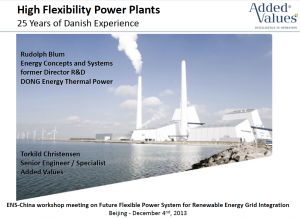Lack of flexibility is one of the biggest obstacles for integration of fluctuating renewable energy in the Chinese power system. The thermal power plants and the transmission grid are currently operated too inflexible, which especially in North China results in massive curtailment of wind power.
Looking more into the problems reveals both technical challenges, lack of economic incentives and regulatory issues as the main reasons for this inflexibility, which damages the further development of renewable energy in China.
Fortunately experiences from other countries show that these problems can be overcome. In Europe curtailment of renewable energy is very small, even in areas with much higher share of renewable energy that in the Northern China.
One of the secrets behind Denmark’s large share of wind power is the extreme flexibility of the thermal fossil fired power plants. Due to years of continuous effort, most of the Danish power plants have very low minimum capacity output for on-grid operation, they have fast up and down regulating capabilities, and they are able to have a quick start-up from zero to full load, compared to power plants in other countries. Establishment of a time-dynamic pricing for power purchase via a well-functioning market has been a strong motivator for this development. The dynamic pricing, with high prices when the demand is high and uncontrolled power supply is low and visa versa, send a clear signal to the power producers when to produce and when to avoid producing.

Danish experiences were presented at a CNREC-RED expert meeting on flexible power plants 4 December 2013
Flexibility for the thermal power plants was the topic to an expert meeting on 4 December 2013, arranged by CNREC and the Sino-Danish RED program. Experts from Denmark shared their experience in how to make coal-fired power plants more flexible. The meeting also discussed the lack of economic incentives for the Chinese power producers to operate more flexibility.
You can find more information about the meeting and the presentations from the meeting here.
